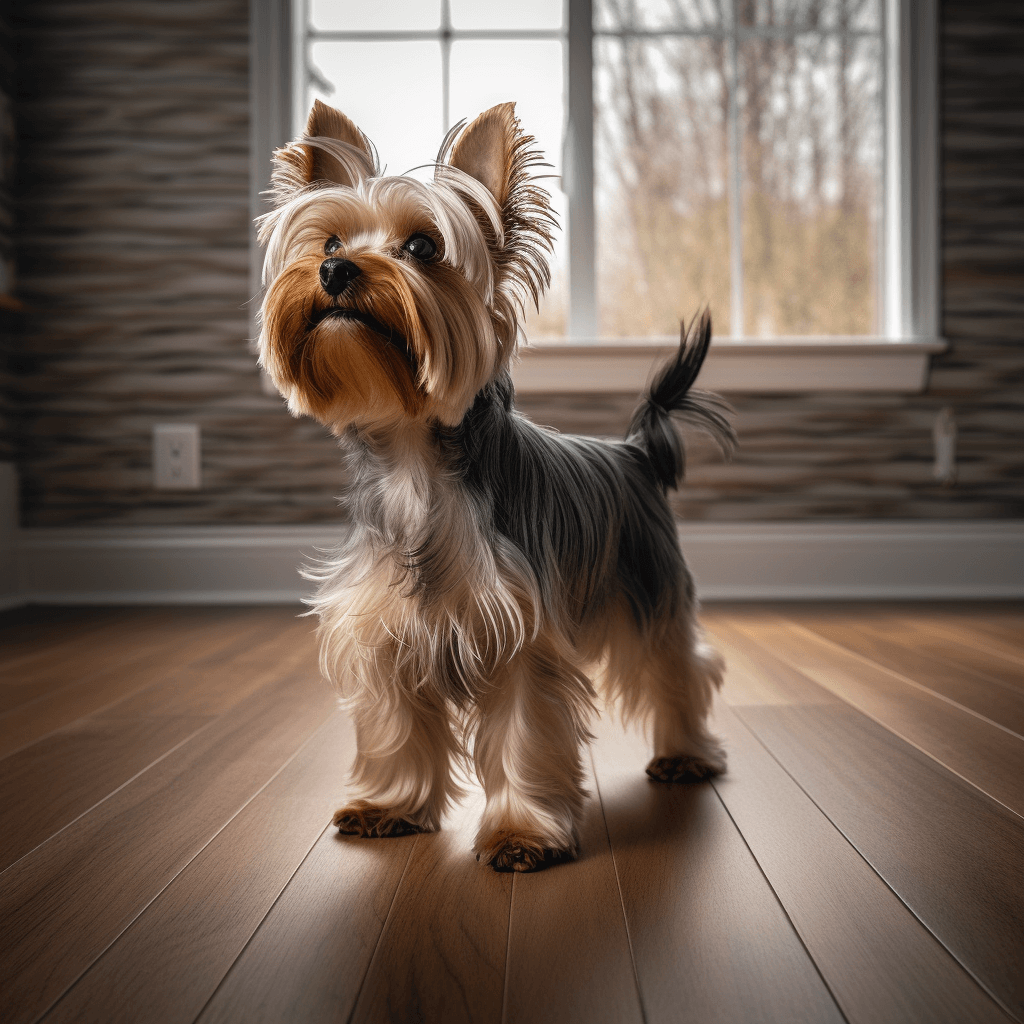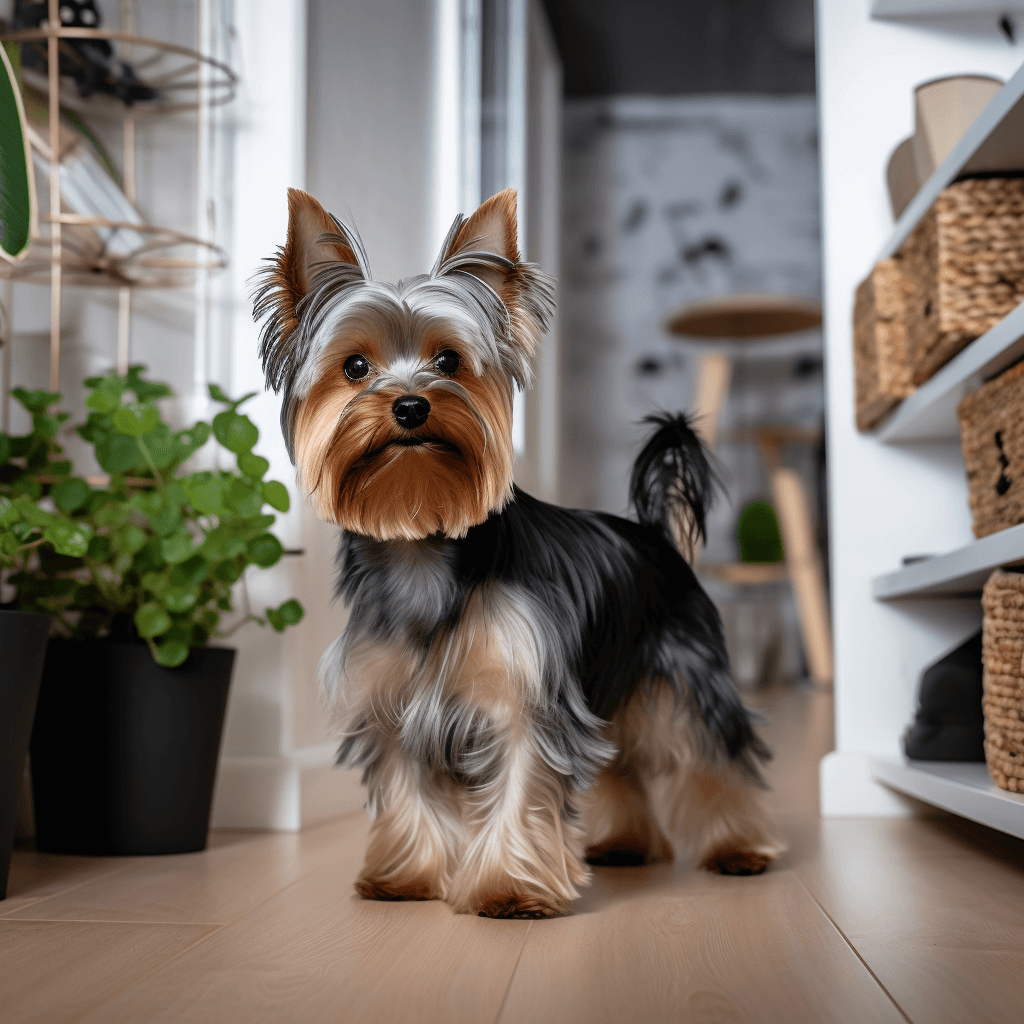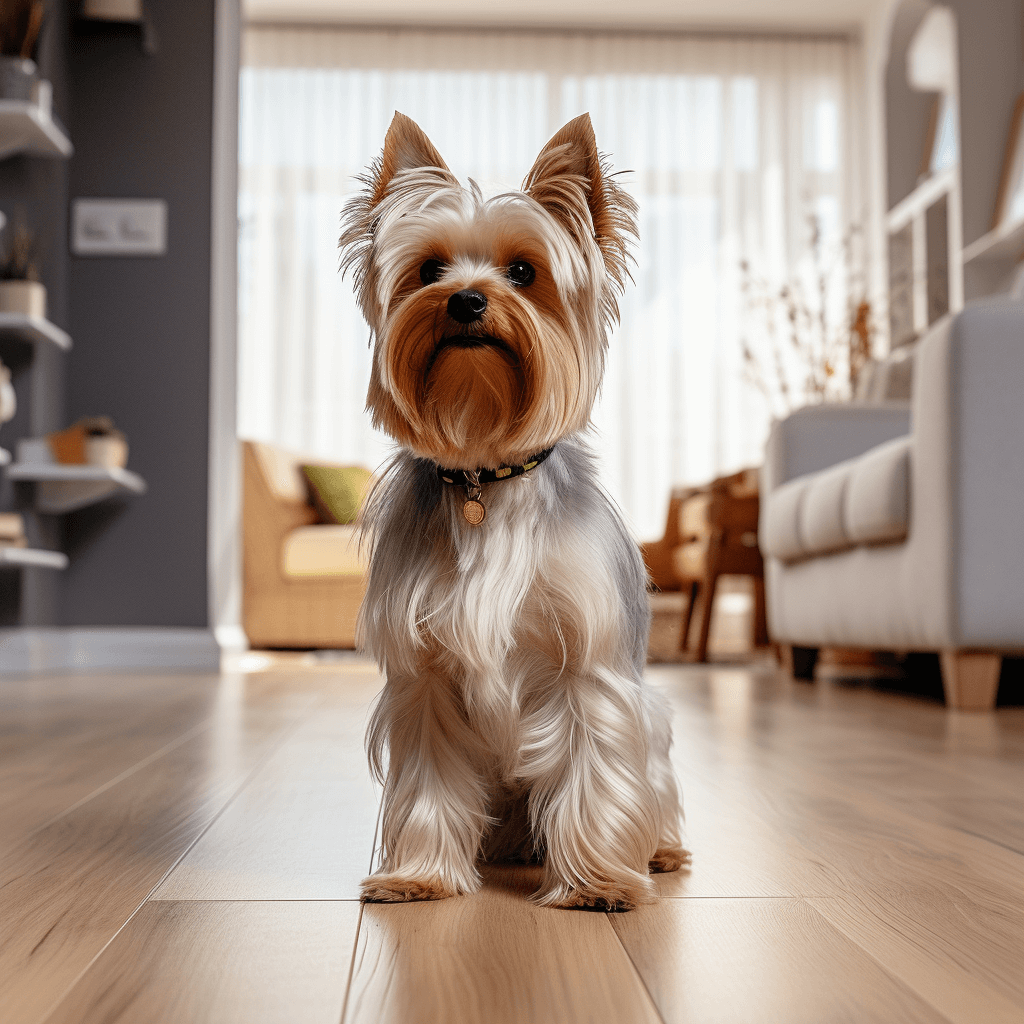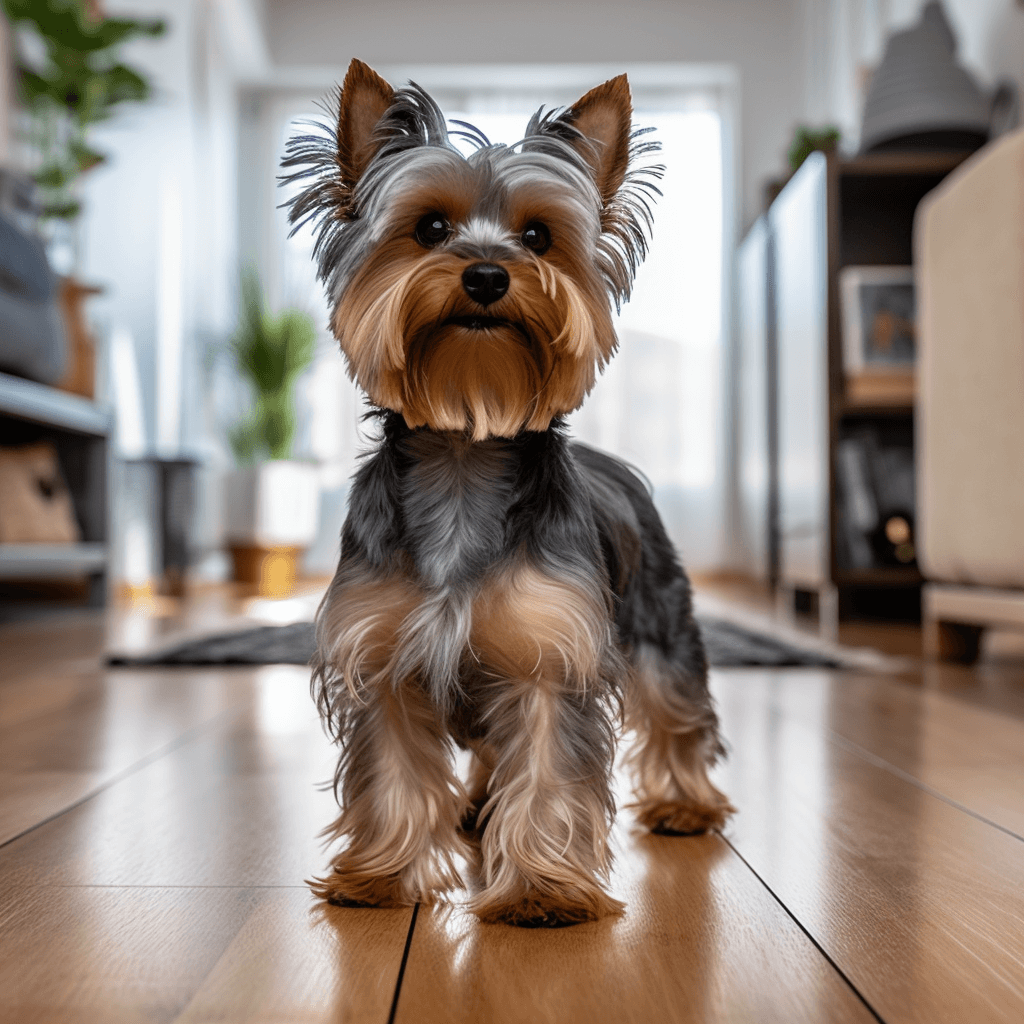The Yorkshire Terrier, often called Yorkie, is a small, charming toy breed known for its long, silky, blue, and tan coat. Originating from England, they were initially bred for hunting rats in mines but soon became popular companion dogs due to their small size and lovable personalities.

Yorkshire Terriers are characterized by their petite stature, weighing around 4 to 7 pounds (1.8 to 3.2 kilograms) and standing about 7 to 8 inches (18 to 20 centimeters) tall at the shoulder. Despite their tiny size, they have prominent personalities. They are confident and affectionate and often think they are much larger than they are.
These dogs are known for their distinctive blue and tan coat, which requires regular grooming to maintain their beauty. Yorkies are a lively and intelligent breed, making them quick learners. They make excellent companions for individuals and families alike, as long as their small size is considered in households with young children or larger pets. Yorkies are often described as loyal, spirited, and a touch sassy, endearing them to many dog enthusiasts worldwide.
These dogs are known for their distinctive blue and tan coat, which requires regular grooming to maintain their beauty. Yorkies are a lively and intelligent breed, making them quick learners. They make excellent companions for individuals and families alike, as long as their small size is considered in households with young children or larger pets. Yorkies are often described as loyal, spirited, and a touch sassy, endearing them to many dog enthusiasts worldwide.

International Canine Federation Standard No. 86 (January 20, 1998)
Origin: United Kingdom.
Date of Publication of the Previous Applicable Standard: June 24, 1987.
Purpose of Use: Decorative terriers.
FCI Classification: Group 3. Terriers.
Section 4. Decorative terriers. Without working trials.
General Appearance: Long-haired. The coat is straight, hanging down evenly on both sides, with a part extending from the nose to the tip of the tail. Very compact and, standing with a vertically set neck, giving an arrogant appearance. The overall appearance conveys the impression of a robust and proportionate body.
Behavior and Temperament: Alert, attentive decorative terrier. Lively, with a balanced character.
Origin: United Kingdom.
Date of Publication of the Previous Applicable Standard: June 24, 1987.
Purpose of Use: Decorative terriers.
FCI Classification: Group 3. Terriers.
Section 4. Decorative terriers. Without working trials.
General Appearance: Long-haired. The coat is straight, hanging down evenly on both sides, with a part extending from the nose to the tip of the tail. Very compact and, standing with a vertically set neck, giving an arrogant appearance. The overall appearance conveys the impression of a robust and proportionate body.
Behavior and Temperament: Alert, attentive decorative terrier. Lively, with a balanced character.

Head
Skull: The cranial box is preferably tiny and flat, not round or overly convex.
Facial Part
Nose: Black.
Muzzle: Not too long.
Jaws and Teeth: Perfect, correct, and complete scissor bite, meaning the upper teeth closely overlap the lower teeth and are set perpendicular to the jaws. Teeth are well-placed in level jaws.
Eyes: Medium size, dark, brilliant, set straight with a penetrating, intelligent gaze. Not prominent. Eyelids are dark.
Ears: Small, triangular, carried erect, not too widely set, covered with short hair, color very dark, deep reddish-brown.
Neck: Good length.
Body: Compact.
Back (from withers to loin): Straight.
Croup: Well-supported.
Ribs: Moderate spring of ribs.
Tail: Usually docked to a moderate length, with a lot of hair of a deeper dark steel-blue color than on other parts of the body, especially at the tip of the tail, and carried slightly higher than the level of the back.
Limbs:
Forequarters:
Forelegs: Straight, well covered with hair of deep golden-rusty-brown color, lighter at the ends, not extending higher than the elbows.
Shoulders: Slanting.
Hindquarters:
Hind legs: Straight when viewed from behind, moderately angulated at the stifles. Well, it was covered with hair of deep golden-rusty-brown color, lighter at the ends, not extending higher than the knees.
Feet: Round; nails are black.
Movement: Free, with drive; straight front and rear movement, maintaining a level topline.
Skull: The cranial box is preferably tiny and flat, not round or overly convex.
Facial Part
Nose: Black.
Muzzle: Not too long.
Jaws and Teeth: Perfect, correct, and complete scissor bite, meaning the upper teeth closely overlap the lower teeth and are set perpendicular to the jaws. Teeth are well-placed in level jaws.
Eyes: Medium size, dark, brilliant, set straight with a penetrating, intelligent gaze. Not prominent. Eyelids are dark.
Ears: Small, triangular, carried erect, not too widely set, covered with short hair, color very dark, deep reddish-brown.
Neck: Good length.
Body: Compact.
Back (from withers to loin): Straight.
Croup: Well-supported.
Ribs: Moderate spring of ribs.
Tail: Usually docked to a moderate length, with a lot of hair of a deeper dark steel-blue color than on other parts of the body, especially at the tip of the tail, and carried slightly higher than the level of the back.
Limbs:
Forequarters:
Forelegs: Straight, well covered with hair of deep golden-rusty-brown color, lighter at the ends, not extending higher than the elbows.
Shoulders: Slanting.
Hindquarters:
Hind legs: Straight when viewed from behind, moderately angulated at the stifles. Well, it was covered with hair of deep golden-rusty-brown color, lighter at the ends, not extending higher than the knees.
Feet: Round; nails are black.
Movement: Free, with drive; straight front and rear movement, maintaining a level topline.

Coat
Hair: Moderately long on the body, perfectly straight (not wavy), glossy; fine, silky texture, not fluffy. They were falling long on the head, of deep golden-rusty-brown color, darker on the sides of the head, at the root of the hair, and on the muzzle, where the hair should be very long. The tan on the head should not extend to the neck, should not be black in any way, and dark hair should not mix with tan.
Color: Dark steel-blue (not silver-blue), extending from the occiput to the base of the tail, never mixed with reddish, bronze, or dark hairs. The chest's tan hair has a deep, bright underlay. All tan hair near the root is darker than in the middle and transitions to even lighter ends.
Weight: Up to 3.2 kg (7 pounds).
Defects: Any deviation from the points mentioned above should be considered a fault, the assessment of which should be in exact proportion to the degree of the deviation.
Note: Dogs should have two normal testicles fully descended into the scrotum.
Hair: Moderately long on the body, perfectly straight (not wavy), glossy; fine, silky texture, not fluffy. They were falling long on the head, of deep golden-rusty-brown color, darker on the sides of the head, at the root of the hair, and on the muzzle, where the hair should be very long. The tan on the head should not extend to the neck, should not be black in any way, and dark hair should not mix with tan.
Color: Dark steel-blue (not silver-blue), extending from the occiput to the base of the tail, never mixed with reddish, bronze, or dark hairs. The chest's tan hair has a deep, bright underlay. All tan hair near the root is darker than in the middle and transitions to even lighter ends.
Weight: Up to 3.2 kg (7 pounds).
Defects: Any deviation from the points mentioned above should be considered a fault, the assessment of which should be in exact proportion to the degree of the deviation.
Note: Dogs should have two normal testicles fully descended into the scrotum.